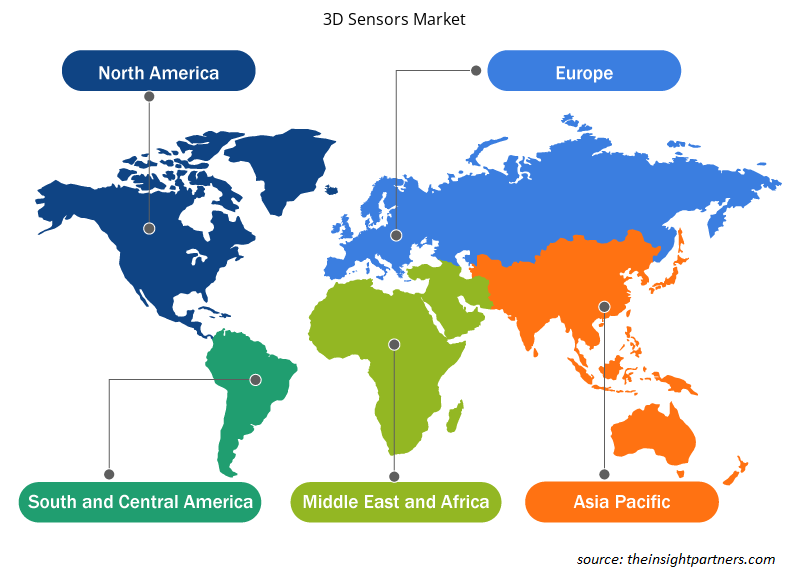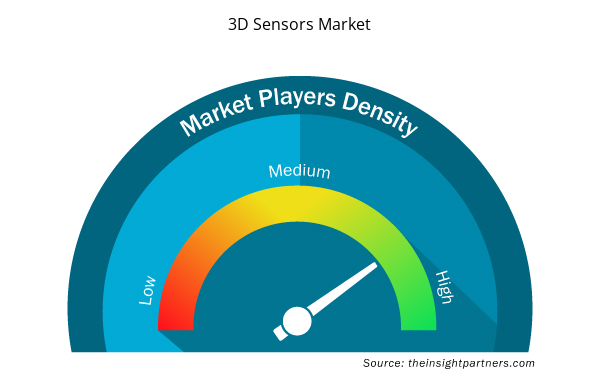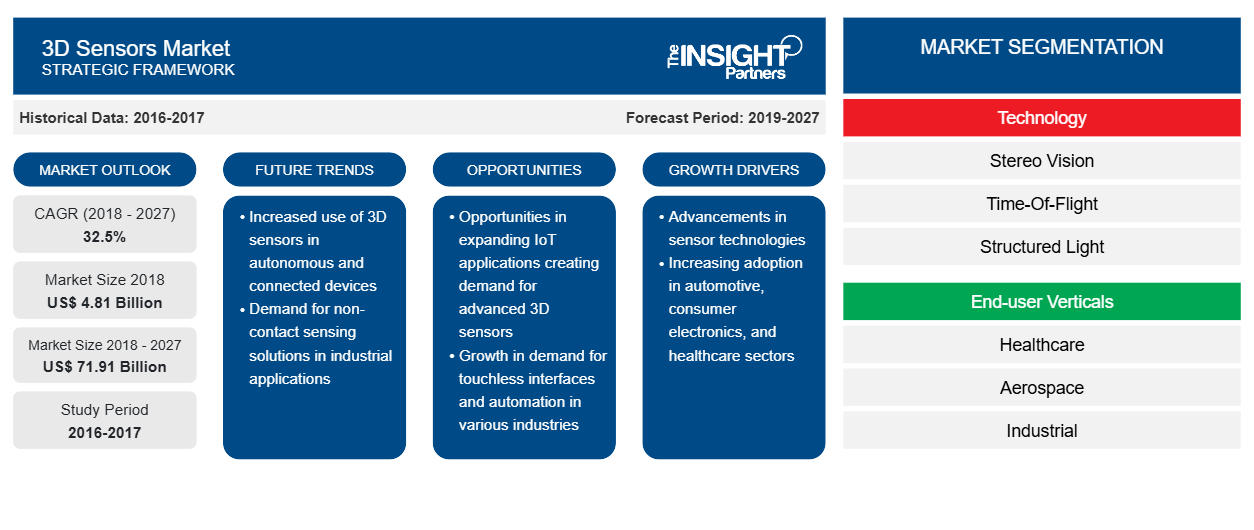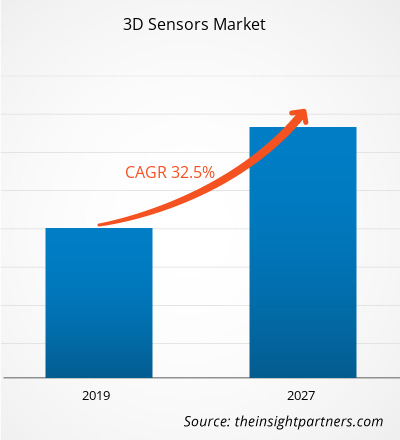[研究报告] 2018 年 3D 传感器市场价值为 48.057 亿美元,预计到 2027 年将达到 719.142 亿美元;预计 2019-2027 年期间的复合年增长率为 32.5%。
3D 传感器使用主动范围传感器,以高帧速率提供深度图像。这些相机配备了照亮视野的红外光源和捕捉反射红外光的 CMOS/CCD 传感器。深度测量基于 ToF 原理;因此,深度与红外信号到达物体或观察场并返回所花费的时间成正比。传感器每个像素获得的深度测量值共同产生深度图像。快速获取深度图像在广泛的终端用户垂直领域非常有用,例如机器人技术、人机交互和场景建模。不幸的是,许多当前可用的 ToF 相机分辨率较低,并且受到不同测量误差的影响,包括传感器引起的噪声、由于难以生成正弦信号而导致的系统性摆动误差、依赖于反射率和积分时间的非线性深度偏移以及深度不均匀性(边缘)处信号叠加产生的飞行像素。因此,ToF 传感器提供准确而精确的深度测量。目前可用的多 ToF 传感器系统专注于结合深度图像,依靠占用概率网格来构建 3D 重建,或者注册从不同视图生成的点云等。
ToF 技术已用于测距十多年。声纳和雷达是两种利用 ToF 原理的声音和无线电信号的技术,特别是在航空航天和航空终端用户垂直领域。最近,随着电子设备的改进和成熟,已经有可能将光信号用于 ToF 系统。使用此类系统的终端用户垂直行业很多,特别是在工业和消费领域。一般来说,使用现代 ToF 传感器测量距离有两种技术:脉冲调制或连续波 (CW) 调制。先进的 ToF 系统采用多频技术,结合了更多的调制频率。
定制此报告以满足您的需求
您可以免费定制任何报告,包括本报告的部分内容、国家级分析、Excel 数据包,以及为初创企业和大学提供优惠和折扣
- 获取此报告的关键市场趋势。这个免费样品将包括数据分析,从市场趋势到估计和预测。
3D 传感器市场区域洞察
Insight Partners 的分析师已详尽解释了预测期内影响 3D 传感器市场的区域趋势和因素。本节还讨论了北美、欧洲、亚太地区、中东和非洲以及南美和中美洲的 3D 传感器市场细分和地理位置。

- 获取 3D 传感器市场的区域特定数据
3D 传感器市场报告范围
| 报告属性 | 细节 |
|---|---|
| 2018 年市场规模 | 48.1亿美元 |
| 2027 年市场规模 | 719.1亿美元 |
| 全球复合年增长率(2018 - 2027) | 32.5% |
| 史料 | 2016-2017 |
| 预测期 | 2019-2027 |
| 涵盖的领域 | 按技术分类
|
| 覆盖地区和国家 | 北美
|
| 市场领导者和主要公司简介 |
|
3D 传感器市场参与者密度:了解其对业务动态的影响
3D 传感器市场正在快速增长,这得益于终端用户需求的不断增长,而这些需求又源于消费者偏好的不断变化、技术进步以及对产品优势的认识不断提高等因素。随着需求的增加,企业正在扩大其产品范围,进行创新以满足消费者的需求,并利用新兴趋势,从而进一步推动市场增长。
市场参与者密度是指在特定市场或行业内运营的企业或公司的分布情况。它表明在给定市场空间中,相对于其规模或总市场价值,有多少竞争对手(市场参与者)存在。
在 3D 传感器市场运营的主要公司有:
- 艾默生公司
- 英飞凌科技股份公司
- 易福门电子有限公司
- 迈来克斯
- 索尼公司
免责声明:上面列出的公司没有按照任何特定顺序排列。

- 获取 3D 传感器市场顶级关键参与者概览
全球 3D 传感器市场细分如下:
全球 3D 传感器市场 – 按技术分类
- 立体视觉
- 飞行时间
- 结构光
全球 3D 传感器市场 – 按终端用户垂直划分
- 卫生保健
- 航天
- 工业的
- 汽车
- 消费电子产品
- 其他的
全球 3D 传感器市场 – 按地区划分
北美
- 我们
- 加拿大
- 墨西哥
欧洲
- 德国
- 法国
- 意大利
- 英国
- 俄罗斯
- 欧洲其他地区
亚太地区 (APAC)
- 中国
- 澳大利亚
- 印度
- 日本
- 韩国
- 亚太其他地区
中东和非洲 (MEA)
- 沙特阿拉伯
- 南非
- 阿联酋
- 中东和非洲其他地区
南美洲
- 阿根廷
- 巴西
- 南美洲其他地区 (SAM)
公司简介
- 艾默生公司
- 英飞凌科技股份公司
- 伊福门电子有限公司
- 迈来克斯
- 索尼公司
- 意法半导体公司
- 巴斯勒公司
- 康耐视公司
- OmniVision 技术公司
- LMI 技术公司
- 历史分析(2 年)、基准年、预测(7 年)及复合年增长率
- PEST 和 SWOT 分析
- 市场规模价值/数量 - 全球、区域、国家
- 行业和竞争格局
- Excel 数据集



Report Coverage
Revenue forecast, Company Analysis, Industry landscape, Growth factors, and Trends

Segment Covered
This text is related
to segments covered.

Regional Scope
North America, Europe, Asia Pacific, Middle East & Africa, South & Central America

Country Scope
This text is related
to country scope.
常见问题
Growing demand for the 3D sensor is a major breakthrough in technology. It is a deep sensing technology that enhances the capacity of a camera to recognize faces and objects. Major companies are using this technology for the development of face recognition in mobile phones and also to accelerate the development and commercialization of high resolution, low power active 3D depth-sensing camera system.
The Asia Pacific region led the 3D sensor market with a market share of 48.3%in 2018. The continuous economic growth in developed and developing countries like India and China, coupled with the presence of huge disposable incomes with individuals in countries like Japan and Australia, has facilitated the rapid growth of the automotive industry in this region. The Asia Pacific is one of the world’s rapidly growing consumer electronic with China accounting for maximum 3D sensor device production. The rapid growth in industrialization and urbanization in the economy is positively impacting the growth of the 3D sensor market in the APAC region. Moreover, the market for the 3D sensor is expected to rise with the growth of end-user verticals industries.
The leading type of 3D sensor is the Time-of-Flight (ToF) that has noted to account a CAGR of 41.9%. ToF is regarded as the sensor that has materialized as a promising three-dimensional (3D) sensing technology that can be manufactured economically in a compact size. In ToF, an infrared strobe emits a bright, short pulse, and a custom detector with a very fast shutter speed measures the time that the light travels before hitting an object. However, current state-of-the-art ToF sensors suffer from low spatial resolution due to physical limitations in the fabrication process
Trends and growth analysis reports related to Electronics and Semiconductor : READ MORE..
The List of Companies
- AMS AG
- Infineon Technologies AG
- ifm electronic gmbh
- Melexis
- Sony Corporation
- STMicroelectronics N.V.
- Basler AG
- Cognex Corporation
- OmniVision Technologies, Inc.
- LMI Technologies Inc
The Insight Partners performs research in 4 major stages: Data Collection & Secondary Research, Primary Research, Data Analysis and Data Triangulation & Final Review.
- Data Collection and Secondary Research:
As a market research and consulting firm operating from a decade, we have published and advised several client across the globe. First step for any study will start with an assessment of currently available data and insights from existing reports. Further, historical and current market information is collected from Investor Presentations, Annual Reports, SEC Filings, etc., and other information related to company’s performance and market positioning are gathered from Paid Databases (Factiva, Hoovers, and Reuters) and various other publications available in public domain.
Several associations trade associates, technical forums, institutes, societies and organization are accessed to gain technical as well as market related insights through their publications such as research papers, blogs and press releases related to the studies are referred to get cues about the market. Further, white papers, journals, magazines, and other news articles published in last 3 years are scrutinized and analyzed to understand the current market trends.
- Primary Research:
The primarily interview analysis comprise of data obtained from industry participants interview and answers to survey questions gathered by in-house primary team.
For primary research, interviews are conducted with industry experts/CEOs/Marketing Managers/VPs/Subject Matter Experts from both demand and supply side to get a 360-degree view of the market. The primary team conducts several interviews based on the complexity of the markets to understand the various market trends and dynamics which makes research more credible and precise.
A typical research interview fulfils the following functions:
- Provides first-hand information on the market size, market trends, growth trends, competitive landscape, and outlook
- Validates and strengthens in-house secondary research findings
- Develops the analysis team’s expertise and market understanding
Primary research involves email interactions and telephone interviews for each market, category, segment, and sub-segment across geographies. The participants who typically take part in such a process include, but are not limited to:
- Industry participants: VPs, business development managers, market intelligence managers and national sales managers
- Outside experts: Valuation experts, research analysts and key opinion leaders specializing in the electronics and semiconductor industry.
Below is the breakup of our primary respondents by company, designation, and region:

Once we receive the confirmation from primary research sources or primary respondents, we finalize the base year market estimation and forecast the data as per the macroeconomic and microeconomic factors assessed during data collection.
- Data Analysis:
Once data is validated through both secondary as well as primary respondents, we finalize the market estimations by hypothesis formulation and factor analysis at regional and country level.
- Macro-Economic Factor Analysis:
We analyse macroeconomic indicators such the gross domestic product (GDP), increase in the demand for goods and services across industries, technological advancement, regional economic growth, governmental policies, the influence of COVID-19, PEST analysis, and other aspects. This analysis aids in setting benchmarks for various nations/regions and approximating market splits. Additionally, the general trend of the aforementioned components aid in determining the market's development possibilities.
- Country Level Data:
Various factors that are especially aligned to the country are taken into account to determine the market size for a certain area and country, including the presence of vendors, such as headquarters and offices, the country's GDP, demand patterns, and industry growth. To comprehend the market dynamics for the nation, a number of growth variables, inhibitors, application areas, and current market trends are researched. The aforementioned elements aid in determining the country's overall market's growth potential.
- Company Profile:
The “Table of Contents” is formulated by listing and analyzing more than 25 - 30 companies operating in the market ecosystem across geographies. However, we profile only 10 companies as a standard practice in our syndicate reports. These 10 companies comprise leading, emerging, and regional players. Nonetheless, our analysis is not restricted to the 10 listed companies, we also analyze other companies present in the market to develop a holistic view and understand the prevailing trends. The “Company Profiles” section in the report covers key facts, business description, products & services, financial information, SWOT analysis, and key developments. The financial information presented is extracted from the annual reports and official documents of the publicly listed companies. Upon collecting the information for the sections of respective companies, we verify them via various primary sources and then compile the data in respective company profiles. The company level information helps us in deriving the base number as well as in forecasting the market size.
- Developing Base Number:
Aggregation of sales statistics (2020-2022) and macro-economic factor, and other secondary and primary research insights are utilized to arrive at base number and related market shares for 2022. The data gaps are identified in this step and relevant market data is analyzed, collected from paid primary interviews or databases. On finalizing the base year market size, forecasts are developed on the basis of macro-economic, industry and market growth factors and company level analysis.
- Data Triangulation and Final Review:
The market findings and base year market size calculations are validated from supply as well as demand side. Demand side validations are based on macro-economic factor analysis and benchmarks for respective regions and countries. In case of supply side validations, revenues of major companies are estimated (in case not available) based on industry benchmark, approximate number of employees, product portfolio, and primary interviews revenues are gathered. Further revenue from target product/service segment is assessed to avoid overshooting of market statistics. In case of heavy deviations between supply and demand side values, all thes steps are repeated to achieve synchronization.
We follow an iterative model, wherein we share our research findings with Subject Matter Experts (SME’s) and Key Opinion Leaders (KOLs) until consensus view of the market is not formulated – this model negates any drastic deviation in the opinions of experts. Only validated and universally acceptable research findings are quoted in our reports.
We have important check points that we use to validate our research findings – which we call – data triangulation, where we validate the information, we generate from secondary sources with primary interviews and then we re-validate with our internal data bases and Subject matter experts. This comprehensive model enables us to deliver high quality, reliable data in shortest possible time.


 获取此报告的免费样本
获取此报告的免费样本